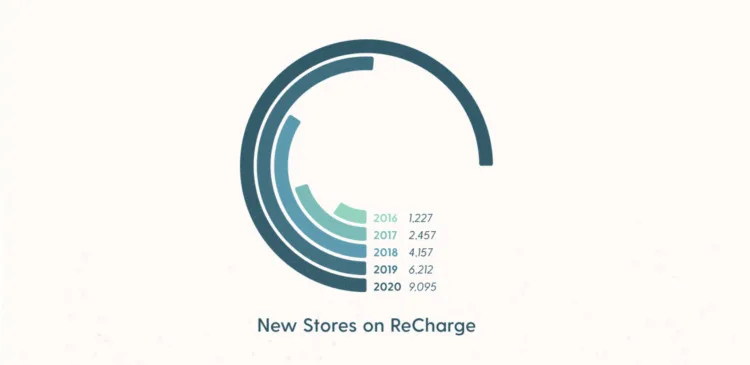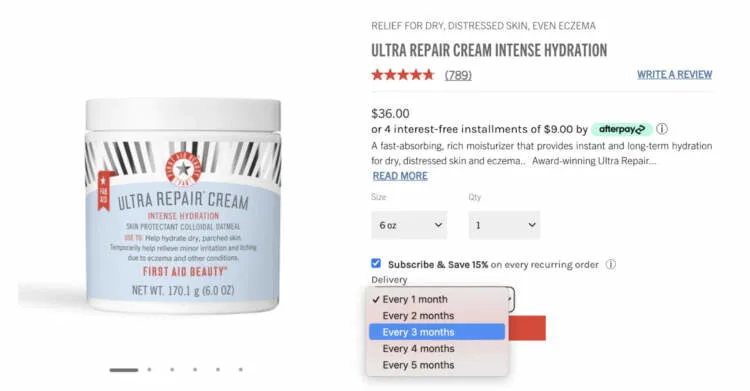Everything You Need to Know About Subscriptions

Remember the days in the not-too-distant past when subscriptions just meant gym memberships and newspaper deliveries? Today, there’s a subscription for pretty much every occasion. In fact, if you wanted to, you could easily fill your entire day with subscriptions from start to finish. The coffee you drink, the clothes and makeup you wear, the software you use, the meals you make and beverages you drink, the shows you stream—all of these and more can be delivered straight to your door on a recurring basis.
From SaaS companies to subscription boxes, the subscription ecommerce market is experiencing monumental growth — and it shows no sign of slowing down.

ReCharge’s latest State of Subscription Commerce Report found that more subscription stores joined the market than ever before, with 90% year-over-year subscriber growth.
With subscriptions, one-time purchases turn into repeat sales. In other words, transactions turn into relationships. Your business has the opportunity to get to know your most loyal customers over time, honing your offerings to meet them where they are. Through delivery skips, product swaps, cross-sells, upsells and more, the flexibility and customization power of subscriptions delivers enormous benefits for both customers and merchants.
Considering offering subscriptions for your brand? Let’s dive into the world of repeat purchases and explore the ways you can meet your subscribers where they are with this offering.
What is an Ecommerce Subscription Service?
Brands are looking to explore providing recurring options to their customers in exchange for higher lifetime value (LTV) and decreased churn. Where in the past, one-time purchases meant shorter relationships with customers and harder work at a return purchase, today, subscriptions offer brands the opportunity to engage with their customers on a longer, more predictable basis.
So, what exactly is an ecommerce subscription? When companies collect recurring payments for products or services they offer on a set, repeating cadence, they’re providing a subscription service. When those products or services are sold online, they’re ecommerce subscription services.
Subscription services can encompass many different product categories, from the most popular (i.e. food and beverage subscription box services) to novelty items like hobby boxes and everything in between.
The Three Types of Ecommerce Subscriptions
Ecommerce subscriptions generally fall into one of three categories: replenishment subscriptions, curation subscriptions (aka “subscribe-and-save”) and access subscriptions. Let’s take a closer look into each to explore their differences in product focus, as well as their benefits for both merchants and customers.
1. Replenishment subscriptions.
Making up 32% of the overall subscription market, replenishment subscriptions refer to products that are used on a regular basis. Think deodorants, laundry detergents and protein shakes — Dollar Shave Club is a great example. These subscription boxes lean on the convenience of regular delivery for customers, providing them with their favorite products just as they’re just about to run out. Also referred to as “subscribe-and-save” (think Amazon’s option), these subscriptions often give discounts to customers who elect to receive the product more than once on a regular cadence.
2. Curation subscriptions.
The most popular subscription type, coming in at 55% in popularity, curation subscriptions were some of the first to market in the recurring subscription world — and they’ve only gained in popularity over the last decade. A curation subscription focuses on boxes of curated products shipped directly to consumers. Product types can vary within a box, or stick to a theme, such as international snacks, meal kits or skincare products. Popular examples of this subscription type include Birchbox and Blue Apron.
3. Access subscriptions.
Access is most commonly used to offer membership or availability to special benefits, content or discounts — for example, streaming services like Netflix. As things like connected hardware and community growth become more popular, utilizing access subscription services is becoming more and more attractive to merchants.
Benefits of Running a Subscription Service
Now that we’ve dug into the types of subscriptions you can offer, let’s explore what these offerings could mean for your business. Recurring revenue, increased acquisition and retention, easier and more accurate forecasting and building a community of brand advocates — all of these and more are possible with intentional subscription offerings.
1. Increase acquisition.
Research shows that new customers are joining the subscription space at unprecedented rates. ReCharge’s latest State of Subscription Commerce report, which studied physical subscriptions, found that from 2019 to 2020 there was an average of 90% growth in subscribers across all verticals. By their very nature, ecommerce subscriptions have many value-drivers that attract new customers, including financial incentives, convenience and novelty or entertainment.
Due to their unique ability to foster customer relationships with the recurring nature of their offerings, ecommerce subscriptions have unique opportunities to increase their acquisitions. Those with strong subscriber communities can leverage positive reviews, engagement on social media and even influencer content to reach new customers and encourage signups. And because these companies are able to study their subscribers’ behavior over time through analytics and market research, they have the opportunity to more effectively target their acquisition efforts for potential customers.
2. Increase retention.
As subscriber growth increased in 2020, so did lifetime value. The State of Subscription Commerce report saw an average LTV growth of 11% in 2020. In other words, subscription customers are spending more over their use of the service before they cancel.
A major opportunity for online stores to increase loyalty and boost retention lies in their customization. According to a McKinsey study, 28% of curation and access subscribers said that the most important reason for staying with a subscription was having a personalized experience. This can include everything from customization of product choices (such as swapping out one product for another or adding a one-time add-on purchase to a subscription) to communication preferences (such as having the option to enable SMS notifications) to frequency of purchases (such as giving options for different frequencies of deliveries or allowing options to skip deliveries). Empowering subscribers to manage their own subscription and customize it to fit their lifestyle increases trust in the business and keeps those customers around longer.
3. Make forecasting easier.
The recurring nature of subscription payments offers enormous benefits not only for customers, but also for merchants. Aspects of the subscription business model like vaulted payment information and scheduled orders create a predictable revenue stream. This has the potential to make forecasting easier and more accurate, and in turn benefits aspects of the business like inventory and supply chain management management.
This recurring nature also means that subscriptions are a valuable tool for tracking product performance and customer behavior over time. If subscription brands are intentional about their data and analytics, they can hone their KPIs over time to reach consumers even more effectively.
4. Build a stronger brand community.
Due to their ability to track customer behavior and product performance over time and their variety of touchpoints to interact with their customers, subscription businesses are uniquely poised to create strong brand communities. This type of engagement offers many benefits for subscriptions that can ultimately help scale the brand. Brands can attract new customers through current community members who leave positive reviews and engage with the brand on social media. These not only foster brand loyalty and increasing lifetime value, but also create valuable feedback loops to improve subscription product offerings. And, when brands interact with community members who engage on social media, they send a signal that they are present and able to deliver a strong customer support experience.
Possible Challenges to Creating an Ecommerce Subscription Service
What are some of the hurdles of running an ecommerce subscription service? For many businesses, the main pain point is shifting from a transactional business model to a relational commerce model. Offering an ecommerce subscription means recalibrating your business processes to embrace this shift.
1. Transitioning to relational commerce business processes.
With a transactional ecommerce store, your main focus is attracting customers and getting a sale, then moving on to the next customer.
With a subscription model and relational commerce, you don’t focus on one and done conversions. Merchants retain subscribers by forming a bond and sense of community around their products, which boosts brand loyalty and drives repeat purchases.
Subscribers are more loyal to strong brands whose offerings align with their personal values. When you can build a brand community around your subscription offerings and create an engaged group of customers, that’s the sweet spot.
2. Lack of differentiation from other subscription services.
Why should future customers sign up for your subscription plan? What differentiates you from your competitors or incentives consumers to become subscribers? These are the main things subscription merchants need to think about to have success.
Differentiation and diversification are key to standing out in a saturated market. Being smaller or just starting out allows you to be more agile and embrace innovation. Successful merchants are able to utilize their data to understand their customers, form a plan of action and meet customers where they are and where they’re going.
Tips for Running the Best Ecommerce Subscription Service
No matter your industry or focus, there are few key themes for setting up your ecommerce subscription service for success. The bottom line: Get to know your customers as deeply as you possibly can, track your learnings over time and pivot your offerings to meet customers’ needs. The more seamless you can make your user experience, the happier — and more loyal — your customers will be.
1. Track KPIs and data.
It’s easy to make assumptions about your customers and their spending habits, but if you’re not using data to back up those beliefs, you’re willfully stumbling around in the dark. Properly tracking the right data is often the lifeblood of thriving subscription ecommerce platforms. Important metrics to consider are customer churn rate, customer acquisition costs (CAC), average order value (AOV) and your customer lifetime value (LTV) or average customer value.
Due to their recurring nature, subscriptions grant merchants an incredible opportunity to collect data about their consumers, which can be harnessed for more in depth personalization (think personalized recommendations, offers or discounts).
2. Make sure you have the right ecommerce platform.
BigCommerce. Shopify. Woocommerce Subscriptions. Subbly. Different ecommerce platforms are better suited for different needs — but with so many different options to choose from, it can be hard to decipher which would best serve your subscription platform.
Are you looking to run a fairly basic monthly subscription box offering? Are you looking for a niche custom headless build? Or are you looking to implement an omnichannel business model, where customers are getting the same, high-quality brand experience whether they are purchasing off your website, social media or in a brick-and-mortar store? What will your pricing model be? What payment gateways will you be using? What will your transaction fees be from your ecommerce platform? What does the subscription management experience look like?
These are important questions to answer when running a subscription-based business. You need to find the ecommerce solution that works best for you and various platforms are better suited for different needs. For example, for merchants who want to offer an omnichannel business model, BigCommerce is an ideal platform. Their documented four pillars of omnichannel success (sales channels, marketing and advertising, operations and fulfillment) allow you to meet your customers where they are.
Do your research before committing to a subscription ecommerce platform and find the one that best suits the needs of your business.
3. Incentivize autopayments and auto renewals.
Subscriptions are ideal for businesses because of the predictive nature of their recurring payments. Making those repeat orders as frictionless as possible is beneficial to both merchants and subscribers, and ensuring customers can make repeat orders on-site benefits your engagement and SEO.
Incentivizing autopayments for your subscriptions provides the customer with convenience and allows the business to more accurately forecast future revenue. You can incentivize subscription products and autopayments over one-time purchases with discounts or bundle deals.
Auto renewals, on the other hand, can be a very valuable retention strategy. Losing a loyal customer because their credit card expired or because they forgot to renew their subscription products is a devastating outcome.
Letting customers know of the various payment options and incentivizing subscription plans that include auto renewals saves your business hardship down the road. Smart businesses also know to notify their customers before their subscription renews. If you want to keep customers in your subscription program and preserve a positive brand affinity (and avoid a headache for your customer support team), notify your customers in advance of any charges going on their account.
Including options to skip a delivery or swap a product is equally as important in these notification emails. Data shows that subscribers who take skip or swap actions stay around for more than twice as many subscription periods as unengaged customers.
4. Make sure the subscriptions align with business goals.
Subscriptions in the ecommerce world are skyrocketing in popularity right now, and they aren’t showing signs of showing down. But starting a subscription business on a whim is no guarantee of success.
Make sure that your subscription offerings align with your business goals long term. Will you dedicate the services and tools necessary for your subscription business to thrive? Are your products optimized for subscriptions, or are they too niche to be ordered on a recurring basis?
In the right hands and supported with the right resources, subscription platforms are a revenue generating machine. Just make sure the business is providing the right services for that machine to be well-oiled.
Key Examples of Ecommerce Subscription Merchants
It’s clear that subscription businesses can take endless forms, and offer enormous potential for both businesses and consumers. Now, let’s dive into a few key examples of merchants that are raising the bar with their recurring product offerings.
1. WebEyeCare.
WebEyeCare is a contact lens and prescription eyeglasses seller that offers consumers a variety of different brand options. Their subscription service falls under the subscribe-and-save model, offering a discount on all recurring orders. However, it also contains some elements of access subscription, as subscribers have access to a dedicated customer service representative.

2. Pure Canna Box.
Pure Canna Box is a curation subscription service that delivers an assortment of customized, all-natural CBD products on a monthly cadence. Items in each delivery are personalized based on an initial quiz that takes customers’ preferences into account, such as their frequency and preferred method of consuming CBD and any allergies.

3. First Aid Beauty.
First Aid Beauty is a skincare brand geared for sensitive skin that offers its products in both major retailers such as Sephora, Ulta and JCPenny and on its own ecommerce site. It offers its products on both a one-time purchase option and a 15% off, subscribe-and-save option for recurring orders, in addition to other benefits such as free shipping and four free samples with every order.

Key Takeaways for Businesses
When considering how to build thoughtful subscriptions for your business, remember: relationships build over time. Keeping your customers around longer all depends on how well you’re able to learn from those customers and listen to their needs, pivoting to meet them where they are with a seamless customer experience and flexible, customizable offerings. The results — increased customer satisfaction, average order value, lifetime value and more — speak for themselves.

Sara is a copywriter focused on lifting up Recharge’s merchants, partners, and their customers. Before Recharge, her past lives included writing and editing at four different subscription meal kit brands, as well as community management and food and beverage reporting for Wine Spectator. Born and raised in Minnesota, she moved to New York for her undergraduate studies at NYU where she studied literature and creative writing. If she’s not writing, editing, eating, or thinking about food, she can usually be found running loops of her local park training for a marathon.


